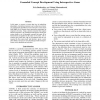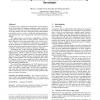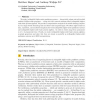193 search results - page 2 / 39 » Atomic models higher up |
MAICS
2003
13 years 8 months ago
2003
In this paper we present a system that uses its underlying physiology, a hierarchical memory and a collection of memory management algorithms to learn concepts as cases and to bui...
AAAI
2011
12 years 7 months ago
2011
Coarse-to-fine approaches use sequences of increasingly fine approximations to control the complexity of inference and learning. These techniques are often used in NLP and visio...
MKTSCI
2010
13 years 5 months ago
2010
A common theme in the marketing literature is the acquisition and retention of customers as they trade-up from inexpensive, introductory offerings to those of higher quality. We e...
ASPLOS
2006
ACM
14 years 1 months ago
2006
ACM
Concurrency bugs are among the most difficult to test and diagnose of all software bugs. The multicore technology trend worsens this problem. Most previous concurrency bug detect...
FSTTCS
2010
Springer
13 years 4 months ago
2010
Springer
We study (collapsible) higher-order pushdown systems -- theoretically robust and well-studied models of higher-order programs -- along with their natural subclass called (collapsi...



